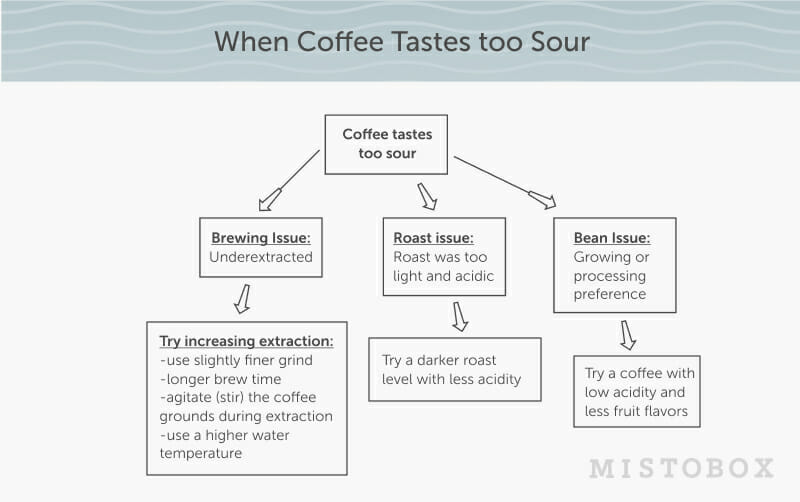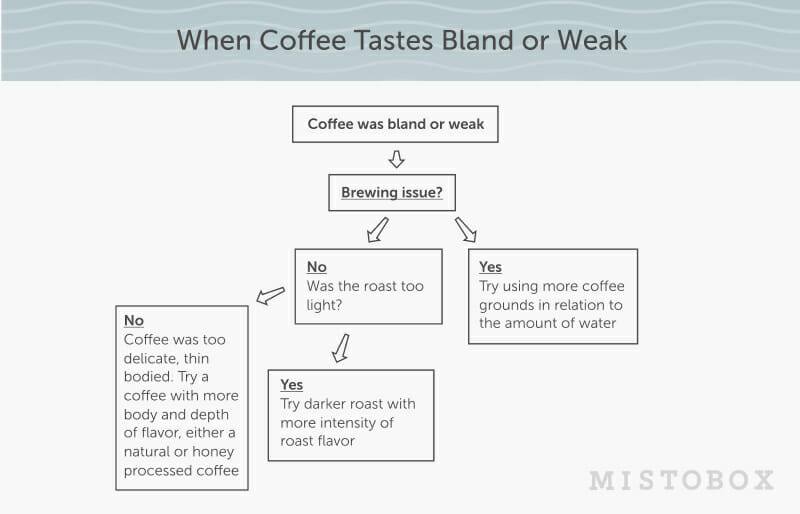Troubleshooting Your Coffee Tasting Issues: Finding the Best Coffee for You

Our mission at Clive is to help people find their ideal coffee. While we do get it right a lot, because coffee preferences are so particular to the individual, we have a good deal of experience working through issues consumers have with finding the perfect coffee.
Listed below are the top 5 issues we see most frequently with coffee tasting and the recommendations we give to help users get to the perfect cup. Sometimes an issue can be solved by changing one or more brewing variables and other times it calls for a change in coffee settings altogether. Ultimately, each consumer is different and will have different tastes, levels of experience, and knowledge, but it’s our hope that armed this actionable troubleshooting guide, we can help you get to your perfect coffee.
Top Coffee Tasting Issues
Issue #1: Coffee tastes sour (or bitter); Coffee was too fruity or too sweet
What this tells us: the roast is likely too light for the consumer’s preference
Those who describe coffee as sour often refer to coffees with a bright acidity, which is more pronounced at a lighter roast level. Many people often confuse bitter tastes with sour tastes, so finding out if the consumer relates bitterness to the acidity or the roast degree is essential to finding a solution. Since single-origin coffees are usually roasted lighter to preserve acidity and flavor, we might suggest opening up a consumer’s preferences to medium and dark roast blends, which will taste less sour, sweet, fruity, and more balanced, bold, and traditional. If they are happy with the roast degree, they may be referring to a natural processed coffee that is much fruitier than a washed or wet-processed coffee. In this case, we recommend switching to processed coffees via the washed method.
Brew Recommendations: If the issue isn’t with the coffee beans, here’s how you might reduce some sour tastes in your brewing method. Sour tastes are often affiliated with too quick of a brew (extraction) time. Try using a slightly finer grind to help increase extraction. This should also slow the brewing process and ensure all desirable coffee flavors have been extracted. Generally speaking, acidic and fruity flavors are extracted first, followed by sweet and bitter tastes, so give your brew a bit more time to extract.

Issue #2: Coffee tastes burnt or bitter
What this tells us: The roast is too dark for the consumer.
Those who describe a coffee as burnt often describe it as too “roasty” or “carbony.” These flavors result from roasting the coffee beans longer and darker. If darker roasted coffees taste burnt or charred, we recommend exploring lighter roasts (light to medium). Once coffee breaks into the medium-dark roast range, plant fibers within the beans begin to break down and burn, contributing to the typical roasty flavors that characterize dark roast coffee.
Brew recommendations: If the issue isn’t with the beans or you’re unsure, try using a slightly coarser grind setting to reduce bitterness in brewing. Too long of a brew (contact) time can cause a coffee to taste bitter or astringent. Remember, acidic and fruity flavors are extracted first, followed by sweet and bitter tastes. Also, darker roasts are more soluble than lighter roasts and can extract bitter tastes more quickly and easily. A larger grind size or lower water temperature with dark roasts will reduce the bitterness you are experiencing.

Issue #3: Coffee tastes bland or weak
What this tells us: The roast level is lighter than the consumer is used to.
Bland or weak-tasting coffee can result from several issues and depend on consumer preferences. More often than not, when people describe a coffee as bland or weak, they want a darker roast with a heavier body and mouthfeel. If the consumer is happy with the roast level, we recommend coffees that aren’t as delicate, floral, or light-bodied.
Brewing recommendations: When addressing brew strength (weakness), we always recommend tweaking the brew ratio to start. If you think the coffee tastes bland, try using more coffee grounds. A ratio (recipe) that calls for more coffee can increase the perceived body, richness, and flavor. More coffee grounds = more strength!

Issue #4: I received a different roast than my preferences are set to
What this tells us: The roast level isn’t what the consumer is used to.
Roast levels can be tricky because each roaster uses its spectrum to define a light, medium, or dark roast. Categorizing can lead to confusion and some discrepancies; for example, one roaster labels a coffee as a medium-light roast while another would label the same coffee as a medium-dark roast. At Clive, we have developed our own objectively calibrated system of scoring coffee roasts to reduce confusion and ensure that we send the right roast levels to consumers each time while working with many different roasters who have some variation in their definitions. We taste every new coffee and analyze it using a tool called a colorimeter, which uses near-infrared light to measure the roast color of the whole-bean coffee and then the ground coffee. The tasting notes are compared with these scores to create the final roast level and standardize the roast designation across our 60+ roasters.
Our preferences as consumers are often driven by the coffee we consume, so if a person is used to a roaster that roasts towards the darker end of the spectrum, they may perceive that they like lighter roasts. But when they try a new roaster’s light roast, it may be too light for them. Again, at Clive, we try to limit this confusion by standardizing our roast levels, but the confusion inevitably occurs. The best thing to do is keep an open mind and communicate with your curator about what you like and don’t like so we can do better for you.

Issue #5: Coffee beans are dry and/or stale
What this tells us: The roast is too light for the consumer.
All our coffee is freshly roasted to order and shipped immediately. This means your coffee is incredibly fresh when you get it, which can always be confirmed by the roast date on the bag. If you notice your beans look dry when you get them, that results from the roast level rather than meaning the beans are stale. Lighter roasts aren’t roasted to a point where the oils reach the surface of the beans, while darker roasts reach higher temperatures for a longer period, which entices the oils to move from the inside of the bean to the surface. If the brew doesn’t look oily enough, try changing your roast preferences towards a darker roast.
Now that you’re armed with some more coffee knowledge, it’s time to give your palate some practice and taste some coffee. Reach out to us at hello@clivecoffee.com, call us at 800-557-5320, or schedule a call to have your own Clive Concierge suggest some coffees to you and help perfect your brew method.